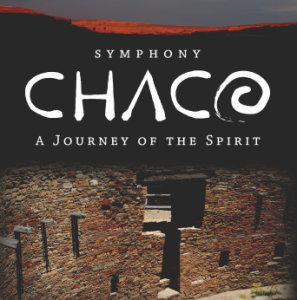History through Music: Meramec Professor brings cultural enrichment to campus
 BY: DALILA KAHVEDZIC
BY: DALILA KAHVEDZIC
Editor-in-Chief
A shallow, red rock canyon which spans 10 miles sits in New Mexico’s northwest corner at 6,200 feet. Around AD 850, a people formerly known as the Anasazi, now the Ancestral Pueblo Tribes, began to construct massive stone buildings. These buildings soared four or five stories high and consisted of up to 700 rooms.
Gary Gackstatter, assistant professor and music director at Meramec, has been teaching full time on the campus for nine years. Throughout the months of July through September, he explored Chaco Canyon and put together a musical piece which he will share with the campus and community on Friday, May 6 through Sunday, May 8.
“Everything is centered around Chaco Canyon – a thousand years ago, thousands of people came to this desolate canyon in what is now New Mexico and they built these huge – what they call great houses. They’re just massive and some of them are five stories high with the floor space of the roman colosseum – 600-700 rooms. They built 14 of them, a total of 3,000 rooms in that canyon,” Gackstatter said.
“They found out later that all the major walls are lined up with the solar and lunar patterns, so these people had an intelligence that drove the design of it.” Gackstatter has been out in the four corners area many times, he said. As you walk out, there is something out there and the English language is very poor at conveying these things. “Everybody that goes out there goes ‘man there’s something powerful out there,’” Gackstatter said. “It draws me to it and for me to dedicate this much time to it, it has to have enough power to pull that. I still don’t feel like I know enough about it.”
Gackstatter wanted to write a piece of music about the ways the Native American culture is connected to the land, sky, each other and the spirit world, he said. “I wanted a deeper connection with nature and Native American Culture and to be able to express that through music,” Gackstatter said. “Words can’t express what’s out there – music can.”
During his time in Chaco, he met different individuals who helped him learn about the area, he said.
“I went out there for two months and met a bunch of archaeologists and scientists and photographers and started – as I walked in the canyon, these melodies would come to me. I wrote them down and then organized it into this ten movement symphony,” Gackstatter said. “We’re going to put all the performing groups together so there will be over 150 people on stage.”
Special guest R. Carlos Nakai, a world renowned Native American flute player, will be performing on Friday, May 6. The event will also host a variety of guest lecturers as well.
A year ago, Gackstatter did not plan for this event, he said. “I went out there with no plans, absolutely no plans, and all these people have crossed my path quite spontaneously and it hasn’t really been any trouble. It’s all fallen together quite naturally and now it’s huge,” Gackstatter said.
Gackstatter said that although this has been in the works for a year, it has not felt like work. “When you’re doing this, creativity is not work. It’s busy and it’s a lot of thought but it’s not work,” Gackstatter said. Gackstatter wants to make this concert more than a concert, he said.
“Most of our concerts – people come, they clap every five minutes and then they go home,” Gackstatter said. “This is interactive, this is experimental, it’s experiential – people are going to be immersed in Chaco Canyon. They can come listen to all these lectures, find out about this place and then really take something home with them that’s meaningful.”
Civilization today is much different and has changed tremendously since the time of the Anasazi, Gackstatter said. “We look around at our civilization and think it’s normal and it’s not,” Gackstatter said. “It’s very fast moving, it’s a fastmoving river but it’s pretty shallow. We’ve lost our connections.” Gackstatter said individuals have their blinders on and never do anything with each other.
“We’re all just tunnel visioned – what I’m doing – and it’s too bad. We miss a lot,” Gackstatter said. “They [Anasazi] were connected to the land and the sky and the spirit world and we’re connected to the internet.”
As he spent time in Chaco Canyon, Gackstatter realized there are a lot more important things in life, he said.
“To be silent for that long of a time and to have your feet on the Earth and your head in the sky, you start to get reconnected with things and realize there’s a lot more important things in life,” Gackstatter said. “Every day in St. Louis I’m in a traffic jam. Every day someone’s coming up behind me going 90 miles an hour honking at me, every day I’m in a hurry and that’s not really how life should be. We should stop and notice the sun and the moon and the stars and seasons changing.”
When one sees themselves as part of the Earth, the sky and the people around them, then they walk like an Indian and see things much differently, Gackstatter said.
“You will never see an Indian in a hurry – they don’t hurry. They just do what needs to be done at the very moment, there’s no extraneous things in their lives. They don’t multitask.”
Others should visit Chaco Canyon to have this same experience, Gackstatter said, as he proceeded to read a quote by Scott Momaday.
“Sacred places are the truest definition of the Earth, they stand for the Earth immediately and forever. They are it’s flags and it’s shields. If you would know the Earth for what it really is, learn it through its sacred places. Here, you touch the pulse of the living planet. You feel it’s breath upon you; you become one with the spirit that pervades geologic time and space.”
Gackstatter said the event is meant to inspire lasting beauty and bring people together.
“Chaco Canyon is where a large number of diverse people came together to make something lasting and beautiful and that’s all we’re trying to do, we’re trying to bring a bunch of people together to make something lasting and beautiful,” Gackstatter said.











